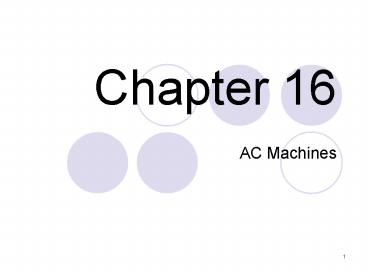AC Machines PowerPoint PPT Presentation
1 / 32
Title: AC Machines
1
Chapter 16
- AC Machines
2
Objectives
- Describe the theory of operation of the
three-phase alternator, and calculate an
alternators input power, output power, losses,
output frequency, and efficiency. - Discuss the process to connect an alternator to a
power grid and remove an alternator from a power
grid. - Describe the principles of operation of the
three-phase synchronous motor. - State the parts of a three-phase induction motor
and describe its principles of operation.
Perform calculations of three-phase induction
motor synchronous speed, rotor speed, slip, and
efficiency.
3
Objectives
- Describe the operating principles of the
single-phase induction motor, define the
operating characteristics of various types, and
perform calculation of speed, slip, and
efficiency. - State the operating principles of the reluctance
motor. - Describe a universal motor and state the
differences and similarities between the
universal motor and the series dc motor.
4
16-1 Introduction
5
16-2 AC Generator (Alternator)
- Output Voltage
- Important Characteristics
- Output Frequency
- Taking an Alternator Online
- Taking an Alternator Offline
- Efficiency
- Synchronous Motor
6
Output Voltage
- Faradays Law e N dF/dt
- e the induced voltage in volts (V)
- N the number of series-connected turns of wire
in turns (t) - dF/dt the rate of change in flux in
Webers/second (Wb/s)
7
Fundamental ac generator.
8
AC generator with rotating field and stationary
armature.
9
Simple three-phase ac alternator and the
resulting output waveform.
10
Important Characteristics of Alternators
- The output frequency of an alternator can be
varied only by changing the rotor speed. - The output voltage of an alternator can be varied
by changing either the field current or the rotor
speed. - The power input to the field (Vf x If) is
dissipated entirely inside the alternator in the
form of heat. - None of the field power is converted to output
power.
11
Important Characteristics of Alternators
- Power losses in the brushes and slip rings is
relatively small. - Brushed and slip rings are in the field circuit.
- Field current is low.
- The output current capacity of the alternator can
be increased simply by increasing the size of the
stator wire. - Higher output current will cause a proportional
increase in the input shaft torque. - This will increase in the mechanical stress on
the field windings. - The rotating field causes an alternating field in
the stator core. - The core will suffer hysteresis and eddy current
losses. - The stator core must be laminated to minimize
eddy currents. - The magnetic field in the rotor core is constant,
so the rotor core does not need to be laminated.
12
Two-pole three-phase alternator armature.
13
Two-pole three-phase alternator and output
voltage waveforms.
14
Output Frequency
- f (P nr) / 120
- f the frequency in Hertz (Hz)
- P the number of poles per output phase
(dimensionless) - nr the rotor speed in revolutions per minute
(rpm)
15
Taking an Alternator Online
- With the alternator offline and field excitation
set to a typical value, increase the speed of the
alternator and prime mover until the output
frequency of the alternator is the same as the
power grid frequency. - Adjust the field excitation until the output
voltage of the alternator is the same as the
voltage of the power grid. - Fine-tune the rotor speed until the output phase
of the alternator is the same as the phase of the
power grid. - Connect the alternator to the grid.
16
Taking an Alternator Offline
- Reduce the power output of the prime mover until
the electrical power being transferred from the
alternator to the grid is near zero (this is
normally monitored using wattmeters). - Open the circuit connecting the alternator to the
grid. - Switch off the prime mover and allow the
alternator to come to a stop.
17
A 12-V dc automotive alternator system.
18
Efficiency
- ? Pout / Pin
- Pout / (Pshaft Pfield)
- (3 Vphase Iphase cos ?) / (T nr / 7.04 Vf If)
- Ploss Pin Pout
- Pshaft Pfield Pout
- (T nr / 7.04) Vf If 3 Vphase Iphase cos ?
- Losses in Alternator
- Field Loss
- Stator Copper Loss
- Stator Core Loss
- Friction and Windage Loss
- Stray Loss
19
16-3 Three-Phase Induction Motor
- Synchronous Motor Speed
- ns 120 f / P
- Slip Speed
- n ns nr
- Slip
- s n / ns (ns nr) / ns
20
Squirrel-cage rotors.
21
16-4 Single Phase Induction Motor
- Resistance-Start Split-Phase Induction Motor
- Capacitor-Start Split-Phase Induction Motor
- Permanent Split Capacitor (PSC) Motor
- Two-Value Capacitor, Capacitor-Start-Capacitor-Run
(CSCR) Motor - Shaded-Pole Induction Motor
22
Stator of a two-pole single-phase induction motor.
23
Single-phase motor (a) main and quadrature flux,
and (b) rotor currents.
24
Main and quadrature flux waveforms and the
resulting sum.
25
Single-phase motor with auxiliary winding.
26
Shaded-pole induction motor.
27
Shaded-pole motor, (a) main pole flux followed by
(b) shaded-pole flux.
28
Shaded-pole motor.
29
Practical Aspects of Single-Phase Induction Motors
- With the exception of the PSC and shaded-pole
motor, all single-phase induction motors use a
centrifugal switch connected in series with the
auxiliary winding. - The capacitor-start, PSC, and CSCR motors contain
one or two capacitors.
30
16-5 Reluctance Motor
31
(a) Reluctance motor rotor construction and (b)
low-reluctance paths.
32
16-6 Universal Motor
- Series-connected motor designed for ac
applications. - Same operating characteristics as series dc
motor. - High Starting Torque
- Poor Speed Regulation
- Very High Speed
- Portable power tools and small kitchen appliances

